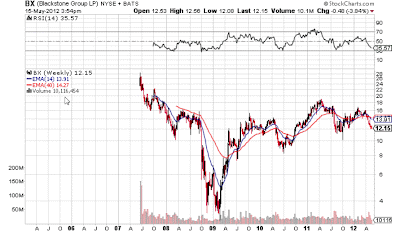I had a request from a friend to slap a few of the charts that I frequently review up again, so I thought that I would oblige. I'll add simply a sentence or two about what I think, but most are very similar in terms of signaling a sell or being very close to doing so.
As we view these charts notice that they are all set to view a weekly time frame and all have a 14 day EMA an 40 day EMA line. Essentially a 14 EMA over the 40 day EMA can be bullish and a 40 day EMA over a 14 day EMA can be very bearish. The slope of this EMA relationship is also important as you'd want to remain skeptical of a bullish signal where the 14 day EMA crosses over the 40 day EMA when the slope is actually heading down. Ultimately, this longer term signal can be useful to capture bigger longer term moves. Almost every chart here has suffered significant damage in the last month or two and so all confirm signals to sell and get into cash.
BLACKSTONE (BX) - $10 or $8 could easily be in reach here. Another JPM hedging fat finger at another bank or hedge fund will send BX much lower.
CATERPILLAR (CAT) - Global growth slowdown. CAT needs a serious reversal to make that right shoulder form or else it is doomed.
Australia Ishares (EWA) - Need some Chinese inflation to save the day, otherwise it will go the path of all commodities without QE3.
Canada Ishares (EWC) - Same as EWA above.
Malaysia (EWM) - I get that toppy feeling here too. Time to exit.
Freeport McMoran (FCX) - The last year gives us a pretty well defined declining trend. Uncle Ben needs to step in to save the metals and the miners. A break below $32 would be disastrous.
Indonesia (IDX) - I hate to bet against this one, but it sure looks like it is about to roll over.
3M (MMM) - I'm inclined to punt this one as it looks to have stalled. I still think it is in the large-cap dividend space which will receive benefits as investors look for yield in all kinds of places. Corporate bond yields are so low, 3M is absolutely got to be a substitute investment for consideration.
Pfizer (PFE) - No reason to panic. Apparently dividend paying drug companies are a shelter from a brewing storm. Beautiful chart here.
Valero (VLO) - Didn't we say sell gas related stuff May 1? See you at $15.
Western Refining (WNR) - This has been a wonderful gift, time to exit. Greed can be a very bad thing if it causes you to lose your money after seeing big gains. Don't let it slip away as $8 is a long way away.
That's it for now. More charts to come later.
GOATMUG

















